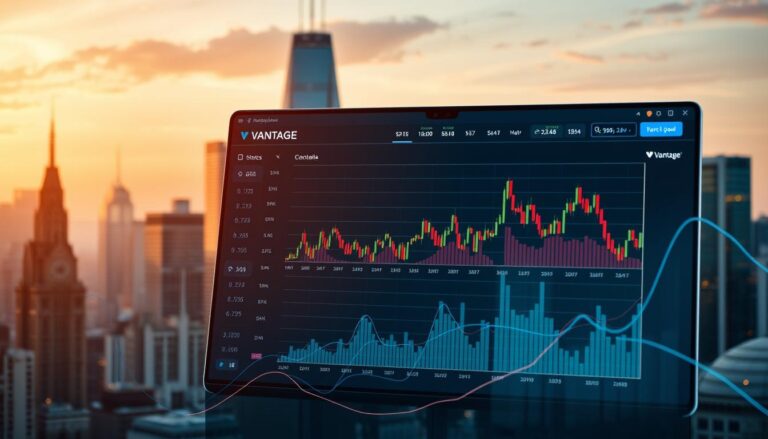How to Start Forex Trading with $10-$100: Low Capital Guide
Many think you need a lot of money to trade in the financial markets. But, you can start with just $10 to $100. This lets you explore global markets, even if you’re new.
Brokers like Exness, regulated by the FCA, let you start with just $1. This is great for those wondering how much money they need. Small accounts teach you discipline and how to manage risks, which are key for success.
Strategies like scalping and swing trading work well with small budgets. But, remember, leverage can increase both your gains and losses. This guide will help you start trading with confidence, even with little money.
Understanding Forex Trading with Low Capital
Starting with a small budget in financial markets is often misunderstood. Many think you need a lot of money to succeed. But, modern brokers offer tools like micro-lots and cent accounts, making it possible to start with minimal deposits.
Why Start with a Small Investment?
Starting with a small budget lets traders learn without taking too much risk. It’s a great way to practice trading strategies and develop discipline. Small accounts also teach the importance of risk management, a skill needed for long-term success.
Platforms like IC Markets and FBS offer accounts starting at $100 or even $1. These options make it easy for beginners to explore currency markets without financial stress. Mobile trading apps also make it easy to trade on the go.
Myths About Forex Trading Minimums
One common myth is that thousands are needed to start. Brokers like Axi and Exness offer accounts with minimal deposits, proving this wrong. Another myth is that small accounts can’t profit. Micro-lot calculations show that even tiny positions can yield returns.
Regulations in the UK, like FCA protections, ensure small balances are safe. This makes it safer for traders to experiment and grow their skills. Tools like Investopedia’s simulator also provide risk-free practice, helping beginners gain confidence.
Choosing the Right Broker for Small Accounts

Finding the right broker is key for those starting with limited funds. Not all brokers are suitable for small accounts. Look for ones that offer micro and cent accounts, competitive spreads, and clear fee structures.
Micro and Cent Account Options
Brokers like Exness and FBS offer accounts with deposits as low as $1. These micro and cent accounts are perfect for beginners. IC Markets, for example, provides tight spreads of 0.6 pips on EUR/USD, reducing trading costs.
It’s also important to compare execution models. ECN brokers offer direct market access, while market makers act as counterparties. Each model has its pros and cons, so choose based on your trading style.
Leverage and Margin Requirements
Leverage can amplify both gains and losses. Exness offers up to 1:2000 leverage for micro accounts, but this comes with higher risks. Always calculate margin requirements carefully. For instance, FXTM’s margin calculator shows that a $10 deposit can open a small position.
Regulations also matter. FCA-regulated brokers provide stronger investor protection compared to offshore brokers. Always verify a broker’s regulatory status before depositing funds.
Hidden fees can erode profits. Even “commission-free” accounts may have wider spreads or inactivity charges. Review the fee structure thoroughly to avoid surprises.
Types of Accounts Suitable for Beginners

Choosing the right account type is a key decision for beginners in financial markets. Different accounts cater to varying needs, budgets, and strategies. Understanding these options helps traders make informed choices and maximize their chances of success.
Standard vs. Mini vs. Cent Accounts
Standard accounts are best for traders with big budgets. They have full lot sizes and tight spreads. But, you need a big deposit, often over $500.
Mini accounts are for those with smaller budgets. They let you trade in micro-lots. Brokers like FXTM start these accounts at just $10.
Cent accounts are great for beginners. They let you trade in nano-lots. You can start with just $1. This is perfect for learning without losing a lot of money.
VIP and Professional Accounts: Are They Worth It?
VIP and professional accounts are for those with lots of money. They offer special perks like lower spreads. But, you need to deposit at least $5,000 to $50,000.
These accounts might not be worth it for newbies. There can be hidden costs like fees or wider spreads. Make sure the benefits match your trading goals.
For example, Pepperstone’s RAW account starts at $200. It has tight spreads, making it good for those who want to grow.
- FXTM’s $10 Micro Account: Great for beginners, with low-risk trading.
- IC Markets’ $100 ECN Account: Offers direct market access and tight spreads for intermediate traders.
- Cent vs. Standard Spreads: Cent accounts have spreads around 3 pips, while standard accounts offer spreads as low as 0.1 pips.
- Swap Rates: Overnight positions incur swap rates, which can impact profitability in long-term trades.
- cTrader Compatibility: Make sure your chosen account type supports platforms like cTrader for seamless trading.
Knowing about these account types helps traders navigate the markets better. Whether you start with $10 or $5,000, there’s a right account for you.
How Much Money Do You Really Need to Start?

You don’t need a lot of money to start in the financial markets. Even $10 to $100 can get you started. It’s important to understand the costs involved.
Breaking Down the $10-$100 Range
Starting small teaches you discipline and how to manage risks. For example, a $100 account can risk $1-$2 per trade. This way, you only risk what you can afford to lose.
Trading in micro-lots is safer. FXTM charges $0.03 per micro lot. Spreads also affect your profits—3 pips on a micro lot cost $0.30.
Hidden Costs to Consider
Expenses like VPNs, education, and tools add up. Currency conversion fees can also cut into your profits. Always include these in your trading plan.
Leverage limits, like the FCA’s 50:1, affect your strategies. Swap rates vary, so calculate your break-even points carefully. With a $100 budget, you can grow your money over six months with the right plan.
| Cost Type | Example | Impact |
|---|---|---|
| Commission | $0.03 per micro lot (FXTM) | Low cost per trade |
| Spread | 3 pips = $0.30 on micro lot | Affects profitability |
| Swap Rates | Varies by currency pair | Impacts long-term trades |
| Non-Trading Costs | VPNs, education, tools | Adds to overall expenses |
Knowing these factors helps figure out how much money need to start. With smart planning and discipline, even small accounts can grow steadily over time.
Risk Management Strategies for Small Accounts
Good risk management is key to success in finance. For those with little money, keeping capital safe is very important. Small accounts need smart strategies to cut losses and grow.
The 1-2% Rule Explained
The 1% rule is a basic rule in risk management. It means risking no more than 1% of your account on one trade. For example, with a $50 account, the max risk per trade is $0.50. This rule helps keep your capital safe even if you lose a few trades.
Some traders use a 2% rule for more risk. But beginners should start with 1% to learn discipline and confidence. Tools like Axi’s margin calculator help find the right position size for your account and risk level.
Setting Stop-Loss and Take-Profit Levels
Stop-loss orders are key to controlling losses. There are two main types: fixed and percentage-based. Fixed stops are set at a certain number of pips from the entry point. For example, a 50-pip stop-loss is simple but might not handle market changes well.
Percentage-based stops adjust based on your account size or trade value. This method is flexible and fits your risk level. For instance, risking 2% of your account on a trade keeps losses in check.
Take-profit levels are also vital. They lock in gains and stop you from losing money due to greed. A common strategy is to aim for twice the profit as the risk.
- Volatility-Based Stops: Adjust stop-loss levels based on market volatility using tools like the Average True Range (ATR).
- Daily Loss Limits: Set a max daily loss to avoid emotional trading.
- MT4 Tools: Use built-in features like trailing stops and risk calculators for better management.
By using these strategies, even small accounts can grow steadily over time. Discipline and careful planning are the keys to success.
Best Trading Strategies for Low Capital

It’s easier than you think to navigate financial markets with little money. The right trading strategies can help small accounts make consistent profits. Scalping and swing trading are two popular methods for beginners.
Both focus on price movements, but they differ in how they’re done and how much time they take.
Scalping with Micro Lots
Scalping means making quick buy sell decisions in short times, like minutes. It works well with small amounts of money, or micro lots. For example, using 15-minute EUR/USD charts can spot trends and when to enter.
The market’s calmness changes throughout the day. The Asian session is quiet, but the London session is busier. Setting a 20-pip profit target on small lots can bring in steady money. But, scalping needs focus and discipline, as quick price movements can cause losses if not managed right.
Swing Trading on a Budget
Swing trading aims to make money over days or weeks. It’s good for those who can’t watch the market all day. Using 4-hour candles can spot trends and possible reversals. Free tools like TradingView alerts can help spot patterns.
Economic calendars are key for swing traders. They help make informed choices. While many trade manually, using algorithms can save time and reduce emotional mistakes.
| Strategy | Timeframe | Risk Level | Best For |
|---|---|---|---|
| Scalping | Minutes | High | Active traders |
| Swing Trading | Days/Weeks | Moderate | Part-time traders |
Both strategies have their good points. Scalping gives quick wins but needs constant watching. Swing trading offers flexibility but needs patience. Keeping a journal helps track progress and improve skills over time.
The Role of Leverage in Low-Capital Trading

Leverage is a strong tool in financial markets, but it must be used carefully. It lets traders control big positions with small amounts of funds. For example, with 1:100 leverage, a $100 deposit can manage a $10,000 position. While it can increase gains, it also ups the risk of losses.
How Leverage Amplifies Gains and Losses
Leverage makes both profits and risks bigger. A 1% market move can lead to a 100% gain or loss with 1:100 leverage. For instance, a $100 investment could grow to $200 or drop to $0. This shows why knowing margin rules and how much to invest is key.
With 50:1 leverage, a 10% loss would cut a $100 account to $50. With 500:1 leverage, the same loss would clear out the account. Brokers have rules to stop big losses, but these rules vary a lot.
Safe Leverage Ratios for Beginners
For those starting with little funds, lower leverage is safer. The FCA limits leverage to 30:1 for retail clients, while ASIC allows up to 500:1. Beginners should use no more than 10:1 leverage for accounts under $500.
Adjusting leverage based on market volatility can also help. During high volatility, using less leverage reduces risk. Using hedging strategies, like opening opposite positions, can also protect against big losses.
| Leverage Ratio | Risk Level | Recommended For |
|---|---|---|
| 10:1 | Low | Beginners with small accounts |
| 30:1 | Moderate | Intermediate traders |
| 500:1 | High | Experienced traders |
High leverage can lead to quick decisions, while lower ratios help with discipline. Many times, using too much leverage can cause big losses. But, by being careful, traders can keep their accounts safe and make steady profits.
Understanding Pips and Lots in Forex

Knowing about pips and lots is key for new traders. These terms help figure out profit loss and manage trades well. A pip is the smallest change in a currency pair’s price. A lot is how big a trade is. Together, they show how much you can win or lose.
Calculating Profit and Loss with Small Positions
For those with small accounts, knowing how to calculate profit loss is very important. A micro lot is 1,000 units of a currency. For example, a 10-pip gain on a $10 account using a micro lot would be $1. This shows how small changes can add up.
Using fractional pip pricing, like 0.1 pip, makes calculations more precise. Tools like the Myfxbook calculator help find the right position size. Keeping an eye on spreads in real-time helps avoid unexpected costs.
Micro Lots vs. Standard Lots: Key Differences
Micro lots and standard lots are very different. A standard lot is 100,000 units of a currency, while a micro lot is 1,000 units. Micro lots are better for beginners or those with little money. For example, trading JPY pairs needs understanding their unique pip values.
Commissions and spreads change with lot size. Micro lots have higher spreads but lower risk. Over 100 trades, small gains can add up to a lot. This makes micro lots easier to handle during market ups and downs.
| Aspect | Micro Lot | Standard Lot |
|---|---|---|
| Size | 1,000 units | 100,000 units |
| Risk | Low | High |
| Pip Value | $0.10 | $10 |
| Best For | Beginners | Experienced Traders |
Mastering pips and lots helps traders make smart choices and manage their accounts well. Whether using micro or standard lots, knowing these basics is essential for success in financial markets.
Psychological Challenges of Trading with Small Balances
Dealing with small balances in trading has its own mental challenges. Limited funds can make emotions like fear, greed, and frustration worse. It’s important to understand these challenges to stay disciplined and succeed in the long run.
Avoiding Overtrading and Reckless Decisions
One big problem is overtrading, where traders make too many moves in a day. This often happens because they want to quickly make back lost money. This leads to making bad decisions.
FOMO (Fear of Missing Out) is another big challenge. In volatile times, the fear of missing a good chance can make traders jump into trades without thinking. This can lead to taking too much risk and losing money.
- Revenge Trading Patterns: Look at past trades to spot emotional triggers.
- FOMO Management: Stick to set entry and exit points to avoid acting on impulse.
- Tilt Management: Take breaks after losses to calm down and think clearly.
Staying Disciplined with Limited Funds
Working with small balances needs discipline. Keeping a trading journal helps track progress and spot patterns. Seeing how demo and live accounts differ can show the stress of real money.
Having a daily routine, like meditation, can help control emotions. Not getting enough sleep can hurt your judgment. So, getting enough rest is key.
- Trading Journal Effectiveness: Review entries weekly to refine strategies.
- Community Support: Join forums or groups to share experiences and gain insights.
- Case Study: Analyze how a $50 account was blown due to emotional decisions.
By tackling these psychological challenges, traders can get better at managing their funds. This is true even with small amounts.
Building a Trading Plan on a Budget
Creating a clear plan is vital for those with limited resources. A good trading plan helps avoid emotional decisions. It leads to steady results. For small accounts, the plan must be realistic.
Setting Realistic Goals for Small Accounts
Start with clear, achievable goals. A 6-month plan can guide your progress. For example, aim to grow a $100 account by 10% each month.
Focus on the process, like reviewing trades or keeping a journal. These habits improve your decision-making over time.
Tracking Progress and Adjusting Strategies
Keep an eye on your performance with a metrics dashboard. Look at win rate, profit/loss, and risk-reward ratio. Tools like Edgewonk can make tracking easier.
Changing strategies is key. If one doesn’t work, figure out why and adjust. For example, reduce risk during volatile markets. Always learn and test your strategies.
| Goal Type | Example | Benefit |
|---|---|---|
| Process-Oriented | Review trades weekly | Builds discipline |
| Result-Oriented | Grow account by 10% monthly | Provides motivation |
| Adaptation | Adjust position sizes | Reduces risk |
By following these steps, even small accounts can grow steadily. A solid trading plan ensures every decision supports your long-term goals. This makes the most of your limited resources.
Common Mistakes New Traders Make
New traders often face challenges that can stop their progress. These mistakes can be costly if not fixed early. Knowing these pitfalls helps traders make better choices and protect their funds.
Overleveraging Small Accounts
One big mistake is overleveraging. High leverage can increase both gains and losses. For small accounts, this can cause big problems. A 14% break-even goal for $1,000 accounts shows the need for careful leverage.
Beginners often try the martingale system, doubling bets after losses. This can quickly lose funds. Instead, use a disciplined approach with lower leverage ratios.
Ignoring Risk Management Basics
Not paying attention to risk management is a big mistake. Even small losses can add up quickly. It’s important to use stop-loss orders and follow the 1% rule.
Too many indicators can confuse you. Using too many tools can lead to bad choices. Focus on a few key indicators to make better decisions.
| Mistake | Impact | Solution |
|---|---|---|
| Overleveraging | High risk of account blowout | Use lower leverage ratios |
| Ignoring Risk Management | Compounded losses | Set stop-loss orders |
| Indicator Overload | Confusion and poor decisions | Focus on key indicators |
Getting too attached to trades is another mistake. Holding onto losing trades can lead to more losses. It’s important to stay calm and follow your plan.
Switching platforms too often can mess up your rhythm. Stick with one reliable platform for better results.
By avoiding these mistakes, traders make progress and grow consistently. Being disciplined and always learning is key to success.
Scaling Up: Growing Your Account Over Time
To grow your account, you need a smart plan and discipline. Even small accounts can grow a lot by focusing on steady returns and smart reinvestment. This section will show you how to scale up and reinvest wisely.
When and How to Increase Your Capital
Increasing your capital should be done step by step. Start with achievable goals, like a 10% monthly growth. This way, you grow steadily without risking too much.
Adding more funds as your account grows is a good strategy. For example, after a 20% return, reinvest some of the profits. This balances risk and reward, helping you grow safely.
- 10% Withdrawal Rule: Only withdraw 10% of profits to reinvest the rest.
- Drawdown-Based Scaling: Adjust capital increases based on drawdowns to minimize risk.
- Performance-Based Bonuses: Reinvest bonuses to speed up growth.
Reinvesting Profits Wisely
Reinvesting profits is key to long-term success. Use a part of your earnings to try different strategies. This spreads out your risk and makes your account more stable.
Look into tax-efficient growth strategies to boost your returns. For example, reinvesting in tax-advantaged accounts can help your money grow faster. Always think about your readiness to scale up before making big decisions.
| Strategy | Benefit | Example |
|---|---|---|
| Phased Capital Increases | Balances risk and reward | Reinvest 20% of profits after achieving a target return |
| Diversification | Reduces reliance on a single strategy | Allocate profits across multiple asset classes |
| Tax-Efficient Growth | Maximizes long-term returns | Reinvest in tax-advantaged accounts |
By using these strategies, you can grow your account steadily. This leads to sustainable success in the markets.
Tools and Resources for Low-Capital Traders
Having the right tools and resources is very important for those starting with little money. These tools help you understand currency movements and learn the basics. They make navigating the exchange easier.
Free Charts and Analysis Platforms
Platforms like TradingView offer free tiers with advanced charting. These tools help you spot buy sell chances and trends without cost. Myfxbook is great for portfolio analytics, helping you track and improve your strategies.
MT4 is perfect for automated analysis with backtesting options. It’s great for testing strategies before using them live. Forex Factory’s economic calendar also keeps you updated on market events, so you’re always in the loop.
Educational Materials for Beginners
Babypips School is a top choice for beginners. It offers a wide range of lessons on forex and more. From basics to advanced strategies, it’s a valuable learning resource.
Broker-specific webinars and Discord trading communities offer insights and support. These platforms let you connect with seasoned traders and learn from them. Tools like Edgewonk help you track your progress and find areas to get better.
- TradingView’s Free Tier: Advanced charting for currency analysis.
- Myfxbook Analytics: Track portfolio performance and refine strategies.
- Babypips School: Lessons for beginners.
- Forex Factory Calendar: Stay updated on market events.
- Discord Communities: Connect with experienced traders.
Even with limited funds, you can build a strong foundation in finance. The key is to stay disciplined and keep learning from available resources.
Turning Small Investments into Consistent Returns
Building wealth with small investments is possible with the right strategy. Focus on long-term growth to turn small funds into steady returns. Tools and strategies for passive income can help you make progress even with limited resources.
Diversifying beyond traditional markets is also key. Exploring new opportunities can reduce risk and increase gains. Always keep learning and adapting to new trends to stay competitive.
Discipline and a balanced approach are essential. Set realistic goals, track your progress, and refine your strategies over time. With dedication and the right mindset, even small investments can lead to big results.


